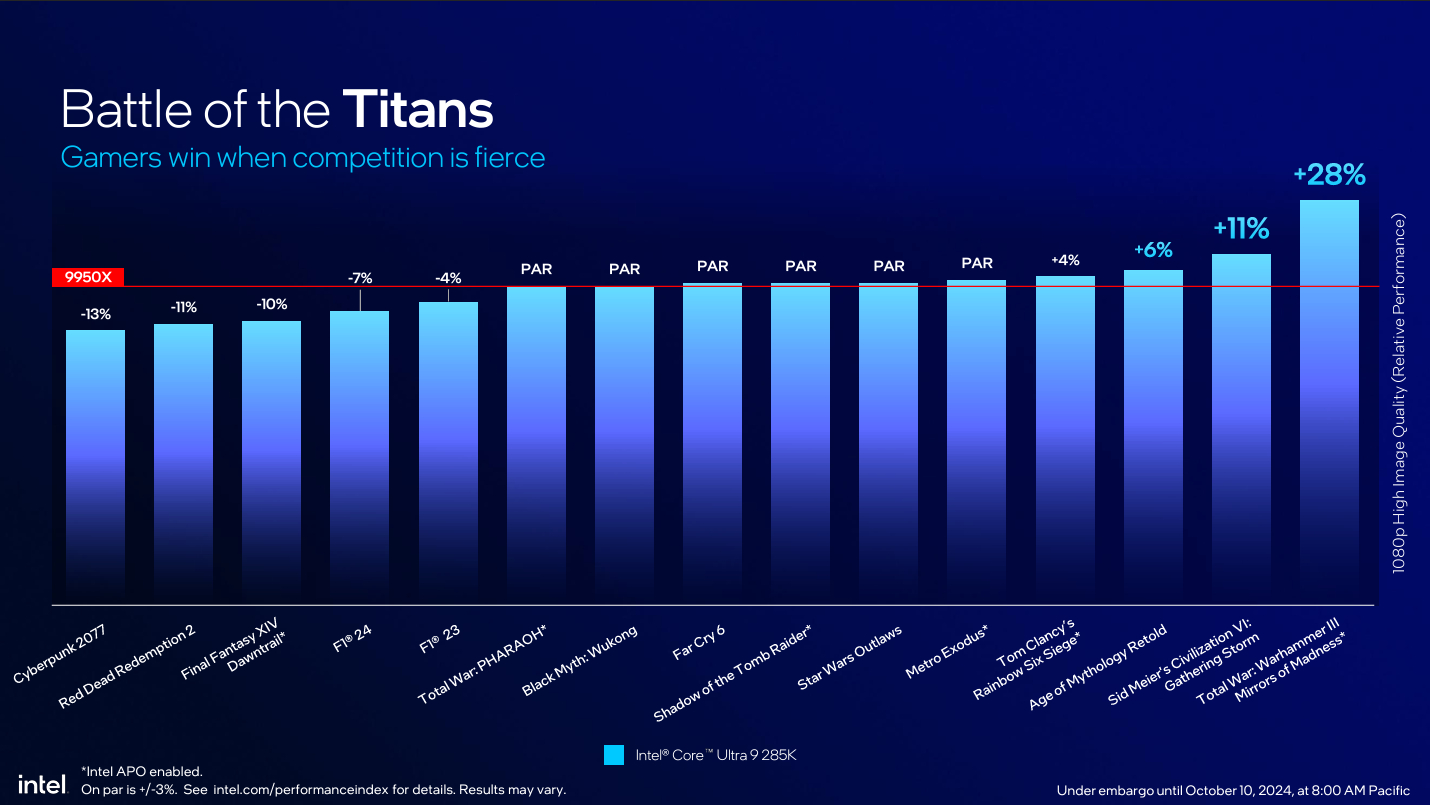In an interview about its Arrow Lake processor launch, Intel admitted that the release didn’t go as planned, citing a disparity between its own results and those from reviewers. It also said it has some performance fixes coming soon that should address those differences. But my own meeting with Intel, and additional tests I’ve carried out since, suggest you shouldn’t expect to see any big gains heading your way.
The promise came from Robert Hallock, Intel’s Vice President and general manager of Client AI and Technical Marketing while chatting with HotHardware. He began by pointing out where Intel has discovered problems. “I can’t go into all the details yet, but we identified a series of [multifactor] issues. They’re at the OS level, they’re at the BIOS level.”
Hallock also remarked on Arrow Lake’s test results, saying that “the performance we saw in review—and to be very clear, through no fault of reviewers—was not what we expected and not what we intended. The launch just didn’t go as planned.”
The phrase “not what we expected” is particularly interesting because in my meeting with Intel, after I provided them with my full set of results and benchmarking methods prior to the review’s release, it said those figures were in line with its internal testing, albeit a little bit behind in some tests.
But even so, I’m not convinced Arrow Lake can be so easily fixed, for gaming at least. I’ve been experimenting with changing the multitude of clocks in Core Ultra 200S processors, as well as testing them with different RAM speeds. The most stable, overclocked configuration I could achieve, with some super-fast RAM, was an 11% increase in the compute tile’s cache ring clock, a 15% increase in the uncore clock (NGU), and a 19% increase in the die-to-die (D2D) clock.
Paired with a 48 GB kit of DDR5-8000 RAM, running in Gear 2 mode, the average performance boost was just 2% to the mean frame rate and a decrease of 7% in the 1% low figures. Mind you, the culprit for the latter was Total War: Warhammer 3. Games such as Cyberpunk 2077 and Baldur’s Gate 3 both improved by around 5%.
However, those gains also came with a mean power increase of 15% in gaming (26% higher in the case of Baldur’s Gate 3). Fortunately, since Arrow Lake isn’t anywhere near as power-hungry as Raptor Lake is in gaming, that power rise is perfectly acceptable.
I’ve also been experimenting with Intel’s Application Optimization tool (APO), which manages the threads generated by certain games to work better on its hybrid architecture. In the marketing slides for the Core Ultra 200S series, all of Intel’s performance results were taken with APO enabled, where relevant.


On my Arrow Lake test rig, using an MSI MAG Z890 Ace and DDR5-6000 CL30, APO makes absolutely no difference with Cyberpunk 2077. It does improve how well Metro Exodus and Total War: Warhammer 3 run, though not massively so.
So if overclocking, high-speed RAM, and APO can’t bring Arrow Lake’s gaming performance up to a level where it’s competitive against Raptor Lake, let alone AMD’s Zen 5, will Intel’s incoming Windows and BIOS fixes make a huge difference?
That’s certainly possible, especially regarding the firmware on motherboards, as the Asus board I used for reviewing the Ultra 9 285K and Ultra 5 245K was hugely better in our Factorio test than either of the MSI Z890 boards I have.

Best CPU for gaming: The top chips from Intel and AMD.
Best gaming motherboard: The right boards.
Best graphics card: Your perfect pixel-pusher awaits.
Best SSD for gaming: Get into the game ahead of the rest.
There is still lots to like about Arrow Lake—the greatly reduced power consumption and the content creation performance—but I think the architecture is fundamentally just not ideal for gaming. In many ways, Intel’s new design strikes me as being similar to Ryzen 3000-series processors, AMD’s first desktop CPUs to use a chiplet design.
Zen 2 and Arrow Lake both have the memory controller in a separate die to the CPU cores, which isn’t great for latency, but AMD is now three generations on from Zen 2 and has improved timings and clock speeds all around to minimise the latency issue. In the case of its 3D V-Cache chips, a massive slab of L3 cache helps out even more.
I hope that Intel does manage to bring Arrow Lake up to the point where it’s a decent enough gaming CPU, if only because most new prebuilt Intel gaming PCs are going to be sporting a Core Ultra 200S chip. But with the Ryzen 7 9800X3D exceeding expectations and selling like proverbial hot cakes, they’re never going to be the best gaming CPUs money can buy.






